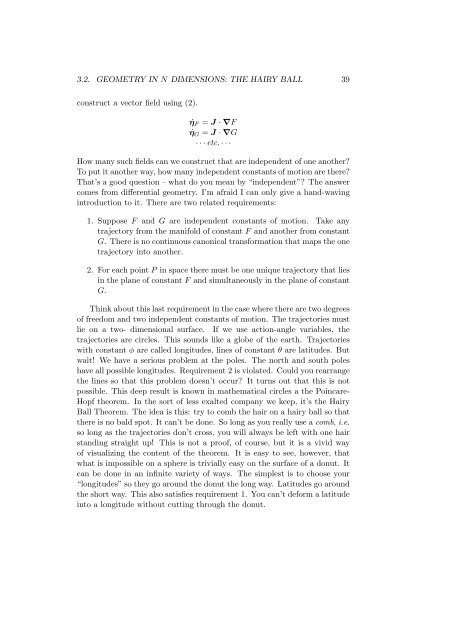Nonlinear Mechanics - Physics at Oregon State University
Nonlinear Mechanics - Physics at Oregon State University
Nonlinear Mechanics - Physics at Oregon State University
Create successful ePaper yourself
Turn your PDF publications into a flip-book with our unique Google optimized e-Paper software.
3.2. GEOMETRY IN N DIMENSIONS: THE HAIRY BALL 39<br />
construct a vector field using (2).<br />
˙ηF = J · ∇F<br />
˙ηG = J · ∇G<br />
· · · etc. · · ·<br />
How many such fields can we construct th<strong>at</strong> are independent of one another?<br />
To put it another way, how many independent constants of motion are there?<br />
Th<strong>at</strong>’s a good question – wh<strong>at</strong> do you mean by “independent”? The answer<br />
comes from differential geometry. I’m afraid I can only give a hand-waving<br />
introduction to it. There are two rel<strong>at</strong>ed requirements:<br />
1. Suppose F and G are independent constants of motion. Take any<br />
trajectory from the manifold of constant F and another from constant<br />
G. There is no continuous canonical transform<strong>at</strong>ion th<strong>at</strong> maps the one<br />
trajectory into another.<br />
2. For each point P in space there must be one unique trajectory th<strong>at</strong> lies<br />
in the plane of constant F and simultaneously in the plane of constant<br />
G.<br />
Think about this last requirement in the case where there are two degrees<br />
of freedom and two independent constants of motion. The trajectories must<br />
lie on a two- dimensional surface. If we use action-angle variables, the<br />
trajectories are circles. This sounds like a globe of the earth. Trajectories<br />
with constant ϕ are called longitudes, lines of constant θ are l<strong>at</strong>itudes. But<br />
wait! We have a serious problem <strong>at</strong> the poles. The north and south poles<br />
have all possible longitudes. Requirement 2 is viol<strong>at</strong>ed. Could you rearrange<br />
the lines so th<strong>at</strong> this problem doesn’t occur? It turns out th<strong>at</strong> this is not<br />
possible. This deep result is known in m<strong>at</strong>hem<strong>at</strong>ical circles a the Poincare-<br />
Hopf theorem. In the sort of less exalted company we keep, it’s the Hairy<br />
Ball Theorem. The idea is this: try to comb the hair on a hairy ball so th<strong>at</strong><br />
there is no bald spot. It can’t be done. So long as you really use a comb, i.e.<br />
so long as the trajectories don’t cross, you will always be left with one hair<br />
standing straight up! This is not a proof, of course, but it is a vivid way<br />
of visualizing the content of the theorem. It is easy to see, however, th<strong>at</strong><br />
wh<strong>at</strong> is impossible on a sphere is trivially easy on the surface of a donut. It<br />
can be done in an infinite variety of ways. The simplest is to choose your<br />
“longitudes” so they go around the donut the long way. L<strong>at</strong>itudes go around<br />
the short way. This also s<strong>at</strong>isfies requirement 1. You can’t deform a l<strong>at</strong>itude<br />
into a longitude without cutting through the donut.
















